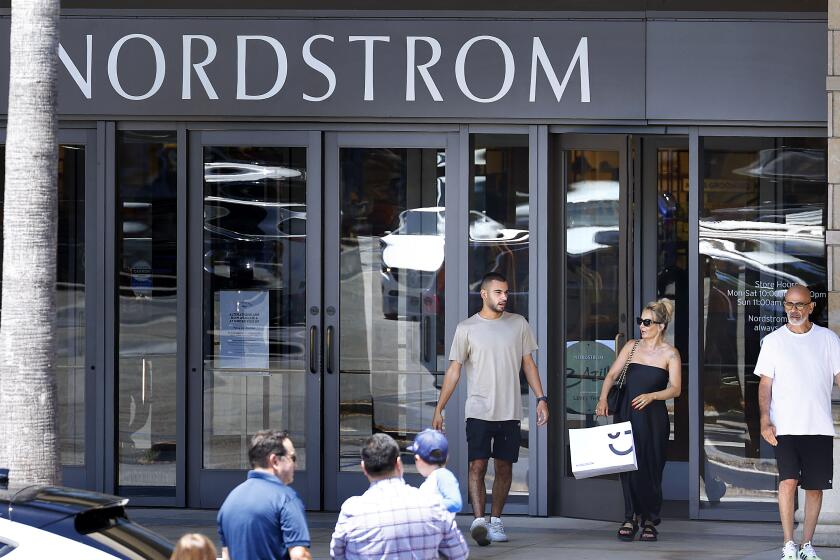Day Runner Struggling to Stay in the Race in Daily Organizer Market
- Share via
Day Runner Inc., the daily organizer company that had such a bright future 18 months ago, has been staggered by mounting debt, growing electronic competition and big retailers that changed the rules of the game.
Today, the 20-year-old manufacturer of paper organizers, planners and software is slashing its work force to staunch the red ink and helplessly watching the value of its shares plummet.
Beset by past problems, Day Runner also must take steps to avoid becoming a dinosaur in an era when computers, the Internet and all things Web are seizing center stage in everyday life. The Palm Pilot and other electronic organizers are Day Runner’s competitors in the future, which is closing in fast.
Meantime, the company has to figure out a way to meet the demands of major retailers such as Office Depot Inc., Staples Inc., Wal-Mart Stores Inc. and Kmart Corp., all of which have reduced inventories to maximize their own profits. By ordering only what they need when they need it, they have put pressure on all suppliers.
Most other vendors, though, have adjusted to the changing demands. Day Runner hasn’t yet.
Earlier this week, the Irvine firm reported lower sales and a quarterly loss of $2.7 million, its third money-losing quarter in the last year, and its stock price, more than $25 a share in mid-1998, had sunk to Friday’s close of $1.69.
The immediate future, if not its long-term health, looks grim.
“It’s a really hard road back for them,” said Alexander Paris Sr., an analyst with Barrington Research in Chicago. “I would advise them to sell, if they can.”
Just 18 months ago, after recording record earnings for its 1998 fiscal year, Day Runner had attracted Wall Street’s attention. Its stock soared more than 33% in less than two months.
Forbes magazine tapped it as one of the 200 best small companies in the nation for the second consecutive year. And Day Runner spent $84.5 million to acquire British rival Filofax Group, a purchase that many believed would propel it to even loftier heights. The price was 50% more than Filofax’s stock value.
But the company had little time to savor the spotlight.
The borrowings to buy Filofax turned the relatively debt-free company into one burdened by $150 of debt for every $100 in equity. Interest payments more than doubled to $3.8 million for the latest quarter from $1.4 million in the previous year’s second quarter.
“Just before everything turned down, they made their biggest acquisition in history and went from a zero-debt position to an overly leveraged balance sheet,” Paris said. The timing “couldn’t have been worse.”
At the same time, Day Runner’s key customers changed their buying habits.
Day Runner was hit particularly hard by the inventory tightening because 64% of its business comes from five large retailers. Its biggest customer, Wal-Mart, accounts for 25% of its sales.
Future demand also suffered as some retailers slowed their own expansions or opened new outlets in lower-volume markets.
In addition, Day Runner’s customers began returning slow-moving items they once would have sold at a discount, said Michael Crawford, an analyst with B. Riley & Co. in Los Angeles.
“Their customers changed the rules of the game on them,” he said.
Corporate executives acknowledge that they were ill-prepared for the shift in inventory management and haven’t been dealing with it well. A year ago, it fired 350 workers, or 20% of its work force, and dismissed 30 more since December.
“We have been surprised by how intense this inventory tightening has been and what a long-lasting and negative impact it has been having on us,” James E. Freeman, Day Runner’s chief executive, said in a press release announcing the company’s latest quarterly results.
Neither Freeman nor other executives would comment further.
Day Runner has to deal not only with its past but its future. Last year, retailers ordered 2.3 million electronic personal organizers valued at $764 million, according to International Data Corp., a market research firm. Orders are expected to grow to 6.4 million units worth $2 billion by 2003.
“I don’t think paper organizers will ever disappear, but they certainly face some stiff competition, which is getting stiffer,” International Data analyst Jill House said.
Day Runner sells electronic organizers and personal planning software, but has been unable to capitalize on Internet possibilities.
Day Runner faced other problems in the last six months.
In July, it hired an investment banking firm to help it boost its stock price, which has continued to drop. In September, the company restated earnings for three quarters because of accounting errors, shaving more than $2 million in profit off the bottom line. Shareholders promptly filed two lawsuits accusing the company of misrepresenting its financial condition. Last month, the company’s chief financial officer, Dennis Marquardt, quit.
Undaunted, Day Runner executives are pushing through with a restructuring aimed at cutting costs.
“Our goal is to complete the bulk of our restructuring this fiscal year and to enter fiscal 2001 as a leaner and profitable organization. We believe this goal is achievable,” Freeman said in the company’s latest press release.
But first, he acknowledged, the company expects to record a “substantial loss” in the current three-month period.
(BEGIN TEXT OF INFOBOX / INFOGRAPHIC)
Tumbling Performance
Beset by heavy debts, stiff competition and a change in the way customers order its products, Day Runner has seen its fortunes and stock price fall sharply since its apex in mid-1998. Quarterly stock closes and latest:
Friday:
$1.69
Day Runner stock hit its high of $25.14 on July 3, 1998
Revenue and profit or loss*, in millions: $196.2 million
--$4 million
*For fiscal years ending June 30
More to Read
Inside the business of entertainment
The Wide Shot brings you news, analysis and insights on everything from streaming wars to production — and what it all means for the future.
You may occasionally receive promotional content from the Los Angeles Times.










